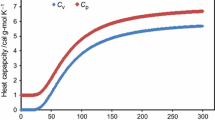Abstract
Approximation polynomial of temperature for the emf of a thermocouple is of high order, with low accuracy and many digits in the polynomial coefficients. These disadvantages are shown clearly in comparison with the approximation of high-temperature heat capacity. The fitting problems result from the fundamental reason, namely, the particular analytical expression for the emf as the function of temperature.
In the approximation theory, this disadvantage is known as Runge’s phenomenon. In this report, it is shown to be typical of the functions with a negative power of the variable, where the derivation produces a factorial.
Similar content being viewed by others
References
F. J. Blatt, Physics of Electronic Conduction in Solids, (McGraw-Hill Book Company, New York 1968.
V. A. Drebushchak, J. Therm. Anal. Cal., 90 (2007) 289.
S. Adamovsky and C. Schick, Thermochim. Acta, 415 (2004) 1.
S. A. Adamovsky (Private communication).
C. Runge, Z. Math. Physik, 46 (1901) 224.
GOST 3044-84, Thermocouples, Gosstandart SSSR, Moscow 1989, p. 79.
P. Debye, Ann. Physik, 39 (1912) 789.
V. A. Drebushchak, Y. A. Kovalevskaya, I. E. Paukov and E. V. Boldyreva, J. Therm. Anal. Cal., 89 (2007) 649.
E. S. R. Gopal, Specific Heats at Low Temperatures, Heywood Books, London 1966.
C. G. Maier and K. K. Kelley, J. Am. Chem. Soc., 54 (1932) 3243.
G. Gospodinov and L. Atanasova, J. Therm. Anal. Cal., 87 (2007) 557.
I. Zieborak-Tomaszkiewicz, E. Utzig and P. Gierycz, J. Therm. Anal. Cal., 91 (2008) 329.
R. K. Kremer, M. Cardona, E. Schmitt et al., Phys. Rev., B 72 (2005) 075209.
I. Danaila, P. Joly, S. M. Kaber and M. Postel, An Introduction to Scientific Computing, Springer, New York 2007, p. 49.
A. Jorba and J. C. Tatjer, J. Approx. Theory, 120 (2003) 85.
A. Quarteroni and F. Saleri, Scientific Computing with MATLAB and Octave, Springer, Berlin 2006, p. 71.
B. Fornberg and J. Zuev, Comput. Math. Appl., 54 (2007) 379.
A. Yazici, I. Altas and T. Ergenc, Symbolic Computational Science — ICCS 2004, Springer, Berlin 2004, p. 364.
F. F. Epperson, Am. Math. Mon., 94 (1987) 329.
J. P. Boyd and J. R. Ong, Commun. Comput. Phys., (2008) (in press).
Author information
Authors and Affiliations
Corresponding author
Rights and permissions
About this article
Cite this article
Drebushchak, V.A. Approximation of the emf of a thermocouple. J Therm Anal Calorim 96, 315–320 (2009). https://doi.org/10.1007/s10973-008-9390-7
Received:
Accepted:
Published:
Issue Date:
DOI: https://doi.org/10.1007/s10973-008-9390-7




